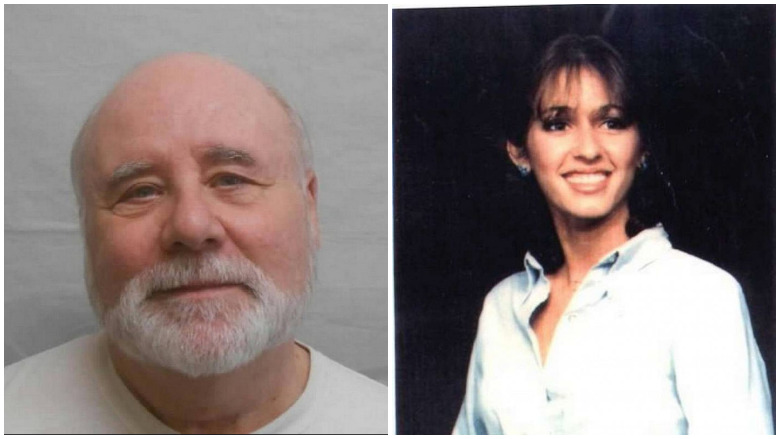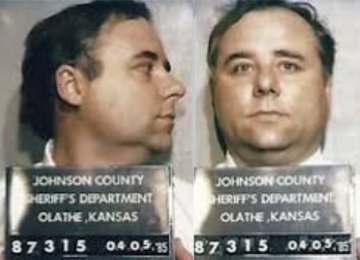
Mugshot/Missing person\'s John Edward Robinson and one of his victims, Lisa Stasi.
John Edward Robinson Sr. was an American serial killer who lured victims using Internet chatrooms with the name “Slavemaster.” Authorities believe he murdered at least seven young women, some possibly with hammers, stuffing their remains in a storage locker and barrels on his rural Kansas property. In some cases, according to court records, Robinson and his victims would enter into “slave contracts” before the murders.
Today, John Edward Robinson is 75 years old and incarcerated in the Kansas prison system.
Authorities argued in court that Robinson murdered one victim – 19-year-old Lisa Stasi – because he wanted to take her 4-month-old daughter and give the infant to his brother and sister-in-law, who were unable to have children. Robinson’s brother Don and Don’s wife raised Tiffany Stasi as their own, renaming her Heather Tiffany Robinson, unaware that Don’s brother had allegedly murdered the child’s mother. Lisa Stasi’s remains were never found, but she’s one of the multiple women Robinson was initially convicted of killing. Robinson’s other known or suspected victims are Izabela Lewicka, Suzette Trouten, Beverly Bonner, Sheila Faith, and Faith’s 15-year-old daughter Debbie. Paula Godfrey, as with Stasi, is still missing, but he’s suspected in her death, as well as that of Catherine F. Clampitt. Altogether, Robinson is accused of five murders in Missouri and three in Kansas.
The state Supreme Court in Kansas later vacated the convictions in the Stasi case and Lewicka’s death. However, Robinson remains on death row because the Kansas court upheld one capital murder conviction for the death of Trouten. The court wrote, “In sum, we affirm Robinson’s capital murder conviction charged in Count II (Suzette Trouten’s death). We reverse his capital murder conviction charged in Count III (Izabela Lewicka’s death) and his first-degree murder conviction charged in Count V (Lisa Stasi’s disappearance) as unconstitutionally multiplicitous with the capital murder conviction in Count II.” You can read that extremely lengthy decision here. The aggravated Interference With Parental Custody conviction in the Stasi case was upheld.
Some people believe that Robinson is the first bonafide Internet serial killer. The Stasi/Heather Tiffany Robinson case will be featured on ABC’s 20/20 on October 4, 2019. The television program features an interview with Heather Tiffany Robinson, who knew Robinson as “Uncle John” before discovering she was being raised by the unwitting family of her mother’s killer.
Heather Robinson is now searching for her mother’s remains. “Justice and closure for me is finding her remains and giving her a proper burial,” Heather Robinson said to 20/20. “Closure is knowing exactly what happened, and peace is finally being able to definitively say Lisa was a person, this is what they did to her, this is where she is and then to be able to finally move on with my life.”
Here’s what you need to know:
1. Robinson Was an Eagle Scout Who Once Sang for the English Queen But Claimed His Childhood Was Abusive

John Edward Robinson Sr.
John Edward Robinson was born in Cicero, Illinois. He was the third of the five children born to Alberta and Henry Robinson. According to a Radford.edu timeline on his life, he was named an Eagle Scout and attended a seminary. He became an X-ray technician, married, and had several children of his own.
Robinson’s father was a binge drinking machinist and his mother was a homemaker, according to CourtTV. As an Eagle Scout, CourtTV reported, he once “sang for the Queen of England and received a kiss from actress Judy Garland backstage.”
However, in court, Robinson claimed he was abused as a child. An expert claimed that her preliminary investigation “suggested Robinson had endured chronic and life-threatening violence, abandonment, and neglect at the hands of his caretakers. When Robinson was 5 years old, his mother began assaulting him several times a week, without provocation—beating him severely, threatening to kill him, and telling him she wished he were dead or never born,” court records say.
“As a small child, Robinson grew deeply attached to his infant brother. The child fell ill and died, and Robinson’s mother blamed him for the death. Robinson was devastated by the loss of his brother and shattered by the false accusations lodged by his mother. As Robinson grew older, the abuse escalated, often leaving him unconscious or bedridden, and his mother isolated him from other family members.”
Another defense expert found that there was “reason to believe Robinson suffered from ‘a bipolar mood disorder’; he ‘was severely physically and emotionally abused throughout childhood’; ‘as a result of this maltreatment, he experiences episodic dissociative states’; ‘as many as four generations of family members may have suffered’ similar mental illness; a 1991 MRI revealed brain abnormalities, ‘allegedly a result of transient ischemic attacks’; and ‘Robinson cannot appreciate the nature and strength of the evidence’ against him,” court records say.
2. Robinson Married & Had Children of His Own

Aerial view of suspected serial killer John Edward Robinson Sr.’s home June 6, 2000 in Linn County, Kansas.
Robinson built a family of his own. According to a Supreme Court decision from Kansas, he “lived with his wife Nancy in a three-bedroom modular home in Olathe, inside Santa Barbara Estates—a large mobile home community. Robinson used computers and e-mail extensively and also utilized a cell phone and pager. Nancy began working as the on-site office manager at Santa Barbara Estates in 1997.”
Robinson’s wife Nancy testified that she met Robinson in 1963 in Oak Park, Illinois. “They married several months later and moved to the Kansas City area in late 1963 or early 1964. Robinson and Nancy had four children,” court records say. “Nancy said Robinson played an important role in the lives of his children and actively participated in and attended their activities. Even when Robinson served time in state prison in the late 1980s and early 1990s, the children visited him and their relationship remained strong. All of Robinson’s children grew to be productive and contributing members of their communities.”
Robinson was also involved in the lives of his grandchildren. According to the court records, “Robinson’s youngest daughter, Christy, had a daughter and younger son. Robinson was involved in the lives of both of Christy’s children and babysat them on a regular basis while their parents were at work. Robinson shared a particularly close relationship with Christy’s daughter, who spent time with Robinson every day. Robinson’s arrest affected her the most because she viewed Robinson as a role model or idol. She became so upset that the family arranged special contact visits, with the approval of sheriff’s department personnel, while Robinson was in jail awaiting trial. Christy’s daughter continued to talk to Robinson by phone during trial.”
In the mid–1990s, the court decision says, “Robinson acquired roughly 17 acres of property at a secluded Linn County location. He moved a trailer onto the property in July 1998 and installed two phone lines: one for his landline and one for his computer.”
He wasn’t a faithful husband. “Though married to Nancy since 1964, Robinson’s infidelity was an ongoing issue in their marriage. In 1998, Nancy learned her husband was involved in bondage and discipline, dominance and submission, sadism, and masochism (BDS&M) activities after discovering fetish websites saved in his Internet browser history. Robinson shared stories of his BDS&M liaisons with Carlos Ibarra, a maintenance employee at Santa Barbara Estates, and showed him nude photographs of a girlfriend depicted in BDS&M poses,” the court records say.
His family, including his wife and two daughters, stayed at his side throughout the trial, according to CourtTV, which quoted a family statement as saying, “The John Robinson we know has always been a loving and caring husband and father, the type of parent who never missed a sporting event, a school function or an opportunity to be there for his family. We do not know the person whom we have read and heard about on TV.”
Heather Robinson told ABC that “Uncle John” always gave her an odd feeling. “[John Robinson] always gave me this really weird, off-putting feeling in the pit of my stomach,” she said to 20/20. “It’s like walking down a dark alley in the middle of the night while you know someone is behind you, approaching you closer and closer.”
Nancy Robinson testified that in early January 1985, “the day of the terrible snowstorm, Robinson brought a baby to their home in Stanley,” court records show. “Robinson said that the baby’s name was Tiffany and that he received her through a private adoption for his brother. Robinson called Donald and Helen and told them a baby was available immediately. He said the birth mother had decided against adoption after delivery, but the family did not support her decision, so she left the baby at a shelter and committed suicide.”
3. Robinson’s Work Life Producing Hydroponic Vegetables & a Mobile Home Trade magazine Was Marred by a Series of Financial Crimes, Including Embezzlement
Robinson couldn’t conform to society’s rules, and he came to law enforcement’s attention through a series of manipulative financial crimes before committing murders. According to the Supreme Court decision, Robinson “was a self-employed, but not entirely successful, entrepreneur. In the 1970s, he formed Hydro–Gro, Inc., a company that produced hydroponic vegetables. In the 1980s, Robinson offered financial consulting services through his company Equi II.”
However, his pathology soon shone through as he ended convicted of financial crimes. “His operations were interrupted when he was convicted of a nonperson felony and incarcerated at the Western Missouri Correctional Center in Cameron, Missouri. Following his release in the 1990s until his arrest, Robinson published a mobile home trade magazine called Manufactured Modular Home Living through his company Specialty Publications,” the court decision says.
Robinson was convicted of theft for embezzling money from an employer and then started selling insurance. He started a medical consulting business and got into more trouble for financial crimes, according to a Radford.edu timeline.
The court records say: “Nancy, in particular, always stood by Robinson. She testified on his behalf when he was convicted of fraud in Johnson County in 1986. She stayed with him after his theft conviction in Missouri and when he went back to prison after his probation was revoked. Despite Robinson’s multiple, ongoing extramarital affairs, Nancy stayed in the relationship. Even Robinson’s conviction for capital murder did not break their marriage. Despite everything, Nancy testified that she still shared a bond with Robinson and that it would continue if the jury spared his life.”
4. John Robinson Told Victim Lisa Stasi He Would Help Her Get Job Training & Put Her Up in a Hotel, Police Say

Lisa Stasi
Authorities say John Robinson met Lisa Stasi, a new mother, in 1984. She was separated from her husband Carl, was only a teen herself, and he told her “he could get her into a job-training program in Texas,” according to The Chicago Tribune. Robinson’s modus operandi was to target vulnerable women having problems in their lives.
She agreed to meet him a Rodeway Inn in Overland Park, Kansas in January 1985, and she took her 4-month-old baby daughter Tiffany with her, The Tribune reported. She was never seen again, and her body was never found. However, according to CNN, authorities think Robinson killed her one day before handing over the baby to relatives. At that time, Heather Robinson was known as Tiffany Stasi.
Police spoke to Robinson at the time but he told them that Stasi left voluntarily with a new boyfriend and her daughter to go to Colorado, according to The Tribune. Police say Robinson murdered Stasi and gave her baby daughter to his brother and sister-in-law, Don and Helen Robinson, who wanted children but didn’t have them.
“I want to find out where she is. I want to know who she was,” Heather Robinson said of her mother to 20/20. “She was a scared, abused, 19-year-old girl with a newborn, desperate to keep her child [and] be a mother. That was the whole reason John got her… I know I will. I’ll find her.”
According to the court records, Lisa Stasi, formerly Lisa Elledge, “was 18 years old when she began dating Carl Stasi sometime after June 1983. Lisa married Carl in August 1984. She was pregnant at the time. On September 3, 1984, Lisa Stasi gave birth to her first child, Tiffany Lynn, at Truman Medical Center in Kansas City, Missouri. After Tiffany’s birth, Stasi’s marriage crumbled and Carl reenlisted in the Navy. He reported for duty at Great Lakes Naval Base, outside Chicago, Illinois, in early January 1985.”
Around the time Stasi began dating Carl, the records say, Robinson “was looking for a private adoption opportunity for his younger brother, Donald Robinson, and Donald’s wife, Helen, who lived in the Chicago area. At a family reunion in 1983, Donald and Helen told Robinson they were pursuing a private adoption. Robinson said he knew an adoption attorney, Doug Wood, and would handle the process for his younger brother. In fall 1984, Robinson told Donald and Helen a baby would be available in October. At Robinson’s direction, Donald sent him a $2,500 cashier’s check payable to Robinson’s business, Equi II, allegedly to cover adoption-related fees. Robinson later said the birth mother had decided not to place the child for adoption.”
In November 1984, Robinson contacted Karen Gaddis, a social worker at Truman Medical Center, and “told her that he and several Johnson County businessmen had developed a program to provide housing, transportation, daycare, and job training for young mothers and their babies,” court records show.
“Robinson said he needed referrals of Caucasian women because the program already had African–American participants and needed racial balance. Robinson was looking for a white woman in her teens or early 20s, who had a newborn child, was struggling or disadvantaged, and had no family support or ties. In January 1985, Robinson told Gaddis another organization, Hope House, had referred a young lady to his program, and he had placed her at a motel in Kansas. Lisa Stasi’s aunt, Karen Moore, testified that she had contacted Hope House and took Stasi to the organization just before January 1, 1985.”
Family members last saw Stasi and Tiffany in early January 1985. “Carl Stasi’s sister, Kathy Klingensmith, babysat Tiffany often. On January 8, Stasi dropped Tiffany off at Klingensmith’s home and told her she had met a man named John Osborne, who was going to help her get a job and finish her GED. Stasi said she might even get to travel as part of the job training program,” the court records say.
Around 4:30 p.m., Stasi “called her mother-in-law, Betty Stasi, in a panic, crying and hysterical. Stasi said ‘they’ were claiming that Betty Stasi planned to take Tiffany away because Stasi was an unfit mother. Stasi’s mother-in-law told her not to believe what ‘they’ were saying because it was not true. Stasi said ‘they’ wanted her to sign four blank sheets of paper. Betty Stasi told her not to sign anything. Stasi said ‘here they come,’ and she hung up,” according to the court records.
Stasi’s family never saw her again. The baby was gone too.
Donald and Helen “flew to Kansas City on January 10. Robinson picked them up at the airport in the late afternoon and drove them to the offices of Equi II in Overland Park, where they signed legal paperwork, including a Petition for Adoption. After signing the documents, Donald gave Robinson a $3,000 cashier’s check payable to Doug Wood, allegedly for further adoption expenses. Donald and Helen named the baby Heather Tiffany Robinson. They returned to Chicago, along with the baby, the following day,” the records show.
Robinson’s name surfaced early in the investigation. On February 1, 1985, Overland Park detectives “interviewed Robinson, who told them he was starting a charitable organization to provide young mothers job training, food, and housing. Robinson admitted he had placed Stasi at the Roadway Inn as part of that program,” the records say. “However, he said Stasi had recently come to his office to give him the motel key. Robinson said Stasi thanked him for the assistance and said she had made other arrangements. Robinson claimed that Stasi and Tiffany left with a young Caucasian male.”
After Robinson’s arrest in 2000, Donald and Helen “began to question the identity of Heather’s birth mother. Law enforcement compared Heather’s footprints to the known prints of Tiffany and found the prints matched, i.e., Heather Tiffany Robinson was Tiffany, Stasi’s biological daughter,” the court records say.
Tiffany’s adoptive parents, Don and Helen Robinson, testified during Robinson’s trial. According to CNN, they described flying to Kansas City from their home in Chicago in January 1985 to pick up the baby.
In court, the Robinsons claimed that John Edward Robinson, who was Don’s elder brother, told them that the mother wanted to give the baby up for adoption. He spun an elaborate tale, according to their testimony, telling them that the mother killed herself after abandoning the child in a shelter. It wasn’t true, of course. Don and Helen weren’t charged because it was believed they were oblivious to John Edward Robinson’s true scheme.
“We named her Heather Tiffany Robinson,” Don Robinson testified, according to CNN, because Tiffany was the name that John Edward Robinson claimed the child’s mother had given her. “…we wanted to keep that in some way.”
According to Helen Robinson’s testimony, as described by CNN, the couple couldn’t have children and felt it would take a long time to adopt through an agency or charity. They mentioned their desire to find a private adoption instead to John Edward Robinson at a family reunion, unwittingly sealing Stasi’s fate, CNN reported.
He met Lisa Stasi and her baby “at a battered women’s shelter in Kansas City,” the timeline says. He claimed his name was John Osborne and picked up Lisa and Tiffany at Lisa’s sister’s home.
5. Robinson, Who Was Known as the ‘Slavemaster,’ Left a Trail of Victims

Lisa Stasi
John Robinson used the name Slavemaster online. He was discovered after a 2000 sexual assault arrest, according to ABC. Authorities then discovered human remains of five women.
The court records gave these details on the other victims. Suzanne Trouten was from Michigan and active in the BDS&M community, frequenting chat rooms and traveling out of state for “BDS&M trysts.” She placed ads on such websites seeking a position as a “slave.” She later told her mother that Robinson “had offered her a job caring for his elderly father, ‘Papa John.’” She agreed to take the job and traveled to Kansas. Robinson admitted engaging in a sexual relationship with Robinson that included a “slave” contract and videotape. At this point, she disappeared. Her mother later received letters from her that authorities think were actually written by Robinson.
Izabela Lewicka was born in Poland and raised in Indiana. She studied at Purdue University and developed an interest in paganism, goth and BDS&M lifestyles, the court records say. She told a friend she was moving to Kansas City to be with an older married man who had offered her a job doing secretarial work and illustrating BDS&M manuscripts. He was going to train her to become a dominant and wanted her to call him master. In Kansas, she worked for a Robinson magazine handling advertising graphics and would indicate she was Robinson’s wife. Authorities also found a “slave contract” in this case. Sometime in late summer or fall 1999, Lewicka disappeared.
Beverly Bonner was from Missouri, where she lived with her doctor husband and two sons. She was a prison librarian at the prison where Robinson was an inmate. Her husband was a prison physician who treated Robinson. She filed for divorce in 1993. She told her husband sh e was helping Robinson “find property for a hydroponics project” and planned to take a job with a Chicago company.
She then disappeared, and Robinson stole her alimony payments. Once again, the victim’s family received fraudulent letters really from Robinson.
Sheila Faith had a baby girl named Debbie Lynn in 1978. Debbie had cerebral palsy. When Sheila’s husband died, she moved to Colorado with the girl and lived on Social Security. She had interest in BDS&M and responded to personal ads, eventually meeting a man named “John” who promised to take her on a cruise and put Debbie in private school. She said she and Debbie were going to meet John but neither was seen again.
Robinson is also suspected of killing Paula Godfrey, who was working at one of his businesses. She has been missing since 1984. Clampitt, another suspected victim, also worked for Robinson and went missing.
Vickie Neufeld was from Texas and had lost her job as a geriatric therapist. She put personal ads on BDS&M websites and started emailing Robinson. He sent her a slave contract. He said he was a wealthy businessman and promised to support her, arranging for her to stay in a hotel. She survived and filed a police report when he wouldn’t return her property, including sex toys.
That started a police investigation, as did a missing person’s report about Trouten. Authorities found Trouten in a barrel with a soft, nylon rope tied around the head. A head injury was lethal. Lewicka was found in the second barrel, in a nightshirt. There were two blunt force injuries to the skull.
The storage unit had three barrels. In one was Bonner, dressed for cold weather, her body curled up inside. She had trauma to the head, consistent with a hammer. Sheila was found there also, again with injuries similar to a hammer. She was wrapped in plastic. Debbie was fully closed and wearing an adult disposable diaper. She had three blows to the head.
The Supreme Court decision outlines the state’s death penalty case against Robinson. It says:
The State’s capital murder theory in Counts II and III was that Robinson killed Suzette Trouten and Izabela Lewicka, along with Sheila and Debbie Faith, Beverly Bonner and Lisa Stasi, and that these killings were all connected, constituting parts of a common scheme or course of conduct characterized by: (1) luring women with offers of employment, travel, and other benefits; (2) exploiting them financially, sexually, or otherwise; (3) killing them and disposing of their bodies in a similar manner; and (4) concealing the crimes through acts of deception and fraud. The State alleged Robinson committed other crimes along the way, including the aggravated kidnapping of Trouten, theft of Neufeld’s property, first-degree murder of Stasi, and aggravated interference with Stasi’s parental custody.
According to CourtTV, he lured some of his victims with “promises of money and jobs and requests for sadomasochistic sex.” In 2000, according to CourtTV, it unraveled when authorities discovered the remains of two women stuffed inside “two 55-gallon barrels sitting out in the open on rural property near La Cygne, Kan.” A storage locker with the remains of three other women was searched next. However, none of those women was Lisa Stasi.